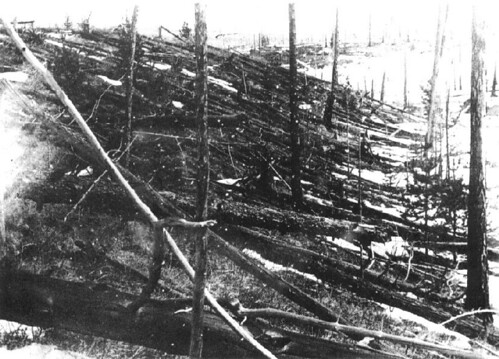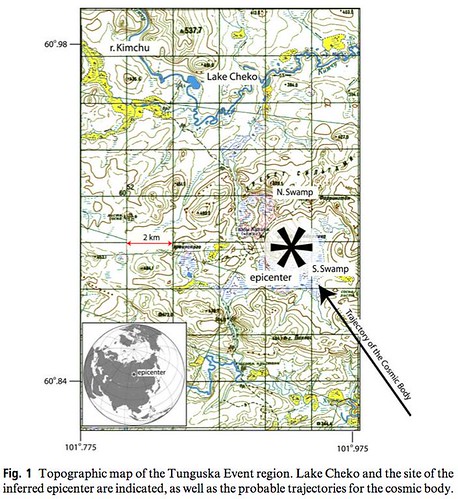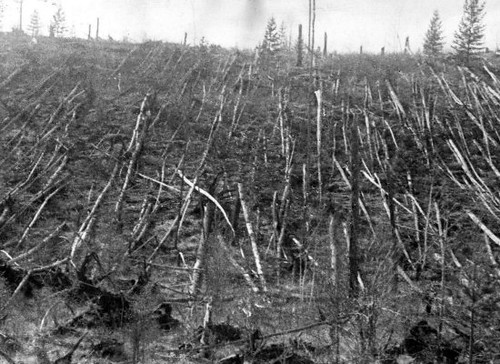tags: researchblogging.org, Tunguska event, Siberian explosion, Podkamennaya Tunguska River, Lake Cheko, planet earth, astronomy
Flattened trees cover vast areas of Northeastern Siberia
after the mysterious Tunguska explosion in June, 1908.
Image: TASS/Sovfoto (public domain?) [larger view].
As a kid, I was fascinated by the mysterious explosion that occurred over Siberia. Basically, in the morning of 30 June 1908, a few native peoples in Siberia reported seeing a blue light in the sky that was as bright as the sun and hearing a series of loud explosions, accompanied by fierce winds and fire. These explosions, which flattened the pristine Siberian Taiga for 770 miles (2,000 kilometers) around, are estimated to have had the power of 2000 Hiroshima atomic bombs. However, this area is so remote and Russia was experiencing so much political turmoil that no one was able to investigate the scene until 1927, when the accompanying black-and-white images first recorded the devastation.
What happened? The hypotheses range from the probable to the blatently ridiculous; a comet or meteor exploded shortly before impacting Earth, a small black hole collided with the Earth, or even Nikolai Tesla made a "death ray" that flattened a section of the Siberian forest. Despite these hypotheses, the mystery remains.
Scientists have carefully explored the area but have never found an impact crater. But based on the size of the devastation and the direction that the flattened trees point, they hypothesized that either a meteor or comet exploded approximately 6 miles (10 kilometers) above the surface of the Earth. Even though an unknown number of native peoples died, this event could have been much worse: if the explosion had occurred approximately 4 hours and 47 minutes later, it would have completely devastated the city of St. Petersburg.
A team of Italian scientists led by Luca Gasperini, a geologist with the Marine Science Institute in Bologna, just published a paper describing their 1999 study where they used acoustic imagery to investigate the bottom of Lake Cheko, located five miles (eight kilometers) north of the explosion's suspected epicenter (see map, below);
[larger view].
They found that the basin of Lake Cheko is not deep, steep and round like a typical impact crater, but instead, it's elongated and shallow, measuring about 1,640 feet (500 meters) long tapering down to a maximum depth of 165 feet (50 meters). (see bathymetry data, below);
[larger view].
Gasperini's team says their data suggest that a 10 meter (33 foot) wide fragment of the celestial object was blasted free by the explosion and continued traveling in the same direction that the original object was moving in. This fragment traveled slowly, about 1 kilometer a second (0.6 mile) per second. When the fragment plowed into the marshy terrain five miles north of the explosion epicenter, it created a long, trenchlike depression.
"It splashed on the soft, swampy soil and melted the underlying permafrost layer, releasing CO2 [carbon dioxide], water vapor, and methane that broadened the hole, hence the shape and size of the basin, unusual for an impact crater," argues Gasperini, adding that "our hypothesis is the only one that accounts for the funnel-like morphology of Lake Cheko's bottom." (See comparison between the morphologies of Lake Nikolaji, which is not an impact lake, to Lake Cheko, and to a known impact crater, below);
[larger view].
But Russian scientists previously concluded that Lake Cheko had formed before 1908, and therefore, could not possibly have been caused by the Tunguska event. Yet, based on their 1999 data, Gasperini's team argues that the older deposits found by the Russians were already there when the explosion took place.
"The funnel-like shape of the basin and samples from its sedimentary deposits suggest that the lake fills an impact crater," Gasperini asserted.
Not that I am an expert, but I wonder about the lack of other, smaller, fragments that should also have been blasted free and impacted the earth along the main fragment's trajectory. Don't you find this lack of other fragments odd? Or perhaps they just haven't been found yet.
Nevertheless, Gasparini's team is planning to return to the area to search for more fragments.
"If the body was an asteroid, a surviving fragment may be buried beneath the lake. If it was a comet, its chemical signature should be found in the deepest layers of sediments."
This study was published in the journal, Terra Nova.
Flattened trees cover vast areas of Northeastern Siberia
after the mysterious Tunguska explosion in June, 1908.
Image: TASS/Sovfoto (public domain?) [slightly larger view].
Sources
L. Gasperini, F. Alvisi, G. Biasini, E. Bonatti, G. Longo, M. Pipan, M. Ravaioli and R. Serra. A possible impact crater for the 1908 Tunguska Event. Terra Nova 19(4):245-251 [free PDF]. (quotes, data images).
National Geographic (quotes).






Everyone's got it backwards. The earth didn't get in the way of an asteroid, comet, or exploding alien spaceship; instead, it simply released a great big fart.
Clearly the pilot ejected before the spacecraft blew up, but his 'chute failed to open ....
Clearly this was a punishment from god. All of those trees must have pissed him off.
People, please. Rasputin's spaceship. Why do you think he was so hard to kill? Or could stop Alexi's bleeding? Or chowed down on poison? Not. Of. This. Earth.
Seriously now (after the last few posts), if there were multiple fragments, but L Cheko was by the the largest, the others would have hit with such little impact, that we would likely miss them today. Woth looking, but such soft swampy ground likely doesn't preserve minor impact sites very long.
Seriously, thank you for this, it's a great find I'm glad you decided to blog about, and I hope we do hear more when they go back hunting.
If the (supposed) piece was "blasted away" but in the same direction as the main object, how exactly would it have been going "slow"? Seems like blasting forward away from a fast moving object would lead to an even faster moving object. Unless we're talking relativity. Or maybe the main object was even slower to begin with...
it's a guess... but maybe an anti-matter/Baryonic reaction (a reaction conataining normal matter and anti-matter), which would have such power, in small concentrations, that could have been the result of several condensed samples that could have somehow found its way around, and note this: that 1 mole of Hydrogen and 1 mole of anti-hydrogen will make approximately 1.8*10^17 joules of energy for just those two moles. Remember that one mole of Hydrogen is 1g, so 2g of reactants make 1.8*10^17 joules of quantized energy, just as einstein had proposed (E=mc^2)... and anti-hydrogen can react with any baryonic (normal) elements and yield even more energy... although it's just a guess from a some punk in high school, so I can't expect you to take it seriously.
Also so you know what happens in these reactions is that hydrogen and anti-hydrogen completely annihilate each other converting them to quantized energy, which can make the most powerful explosions ever witnessed, and there has been several scientist who have asked the US military to investigate in conceiving anti-matter weaponry.
Actually, the Bologna "solution" suffers from one insurmountable problem -- namely, eyewitness accounts establish that Lake Cheko, far from being a "crater" formed in the Tunguska Event, was a well-known landmark on the Vanavara-Strelka trail long before the Event took place. More detail here.
I don't know alot about things like this, but why do there have to be solid rocky or metallic "fragments"? We have a comet in the sky right now that is blowing up and expanding from the inside. Could the body that may have caused the Tunguska event have experienced this same kind of expansion ending in the atmosphere of Earth? Aren't many of these bodies mostly frozen gasses, water etc? Could the "fragments" have become vapor whose chemical fingerprint might remain upon the ground or in the water of the lake (as suggested in the report) as opposed to lumps of rock or metal? Maybe the fragments are tiny? Why do they have to be large?
And what if the chemical signature is the same as/similar to the Earth? The Earth is a "heavenly body", yes? Its water may have come, at least in part, from impact from other heavenly bodies, yes? Or maybe by now, the vapor from this event entered the atmosphere, spread over the Earth and now is everywhere?
Clapping,
Chardyspal
I read the items linked to by Jenkoul, and I must say, some of the wording of the eye witness testimonies actually suggests otherwise (like a road that passed through lake Chekov?).
I think it's very well possible that people referred to the lake as a landmark for the simple reason that by the time people came round to take down their statements, it had been there for at least several decades.
Hi, Number 11 --
You raise an interesting point -- namely, could people have used the lake as a landmark after the Tunguska Event? But the answer is unequivocally no. In the aftermath of the Tunguska blast, the Evenki shamans declared the entire region accursed (by Ogdy/Agdy, the Evenki Thunder God), and would not permit anyone to enter it much less travel across it. Leonid Kulik had a difficult time finding anyone to guide him into the blast zone -- and that was in 1927, nearly two decades after the Event. In the intervening years, no one went there at all and the Vanavara-Strelka trade route fell into utter disuse. Hence, if Lake Cheko was a landmark on that route, it would have had to've been before the 1908 Event.
PS: The Russian preposition in question is "cherez" and can mean either "through," "over," or (perhaps most appropriate of all in this context) "via." The eyewitness is simply saying the road from Strelka went to Vanavara via Lake Cheko -- i.e., this was a landmark one would pass en route.
Best,
Jenkoul